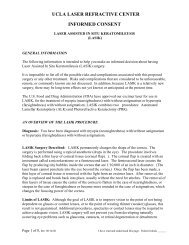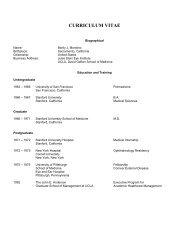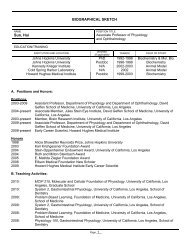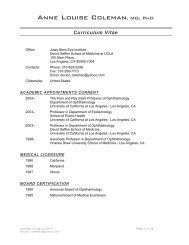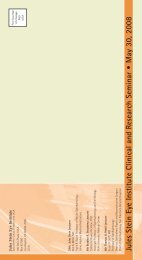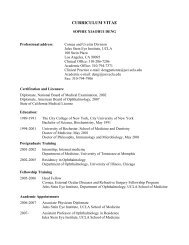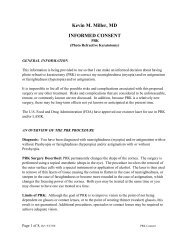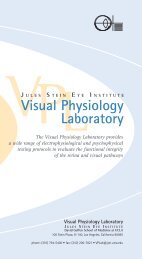View Annual Report - Jules Stein Eye Institute
View Annual Report - Jules Stein Eye Institute
View Annual Report - Jules Stein Eye Institute
You also want an ePaper? Increase the reach of your titles
YUMPU automatically turns print PDFs into web optimized ePapers that Google loves.
sherwin J. Isenberg, mD<br />
Laraine and David Gerber Professor of<br />
Pediatric Ophthalmology<br />
Professor of Pediatrics<br />
Vice-Chairman of the UCLA Department<br />
of Ophthalmology<br />
Chief of the Ophthalmology Division,<br />
Harbor-UCLA Medical Center, Torrance<br />
Member of the <strong>Jules</strong> <strong>Stein</strong> <strong>Eye</strong> <strong>Institute</strong><br />
ReseaRch summaRy<br />
Pediatric Ophthalmology, Amblyopia,<br />
and Ophthalmic Pharmacology<br />
Dr. Isenberg’s research activities have concentrated on<br />
various aspects of surgical and medical diseases of<br />
children’s eyes. The goal is to decrease the frequency<br />
of blindness in children worldwide. In a series of studies<br />
of newborns, Dr. Isenberg has characterized a number<br />
of elements: the type and source of bacteria of the<br />
external eye; the evolution of iris structural changes;<br />
the development of the macula, which is the source<br />
of central vision; and pupillary responses after birth.<br />
Recent publications have characterized the produc-<br />
tion and nature of tears of infants and the develop-<br />
ment of the cornea in the first year of life. He has also<br />
reported the ocular signs in newborns whose mothers<br />
abuse cocaine, facilitating the diagnosis of newborn<br />
cocaine intoxication.<br />
In another avenue of research, povidone-iodine eye<br />
drops have been found to treat bacterial conjunctivitis<br />
successfully in a three-year, international study with the<br />
University of the Philippines. The eye drops were also<br />
found to be safer and more effective in preventing eye<br />
infections than the currently used agents. Dr. Isenberg<br />
and other investigators have now proven that the<br />
povidone-iodine eye drops can treat the number one<br />
cause of preventable pediatric blindness in the world—<br />
corneal infections due to bacteria. These studies,<br />
conducted in children and adults in India and the<br />
Philippines, should reduce the number of 400,000<br />
children now blind from corneal infections. A new study<br />
investigating fungal infections of the eye, which blind<br />
approximately 10,000 children annually, has been<br />
completed at three sites in India.<br />
48 Faculty | Isenberg<br />
Lastly, a new device that reports blood gases from<br />
the conjunctiva, such as oxygen and carbon dioxide,<br />
is being developed. Preliminary trials have been<br />
completed in animals and in adults undergoing<br />
cardiac bypass surgery. The hope is to apply the<br />
device to the eyes of premature newborns. The<br />
continuous readout of tissue blood gas levels should<br />
enable the pediatrician to prevent damage to the<br />
baby’s brain and keep the oxygen at an appropriate<br />
level, minimizing the possibility of blindness from<br />
retinopathy of prematurity.<br />
Public Service<br />
Member, Medical Advisory Board and Board of Directors;<br />
and Research Committee Chair, Blind Children’s Center<br />
President, Costenbader Pediatric Ophthalmology Society<br />
Vice President Elect, American Association for<br />
Pediatric Ophthalmology and Strabismus




